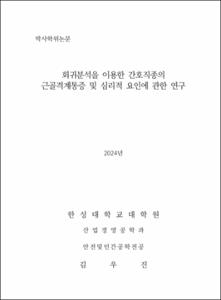회귀분석을 이용한 간호직종의 근골격계통증 및 심리적 요인에 관한 연구
= A Study on the Musculoskeletal Pain and Psychological Factors of Nursing Jobs Using Regression Analysis
- Type
- Thesis
- Department
- 대학원 산업경영공학과
- Issued Date
- 2024
- Publisher
- 한성대학교 대학원
- Files in This Item:
-
-
Download
 200000725067.pdf
기타 데이터 / 1.35 MB / Adobe PDF
200000725067.pdf
기타 데이터 / 1.35 MB / Adobe PDF
-
Items in Repository are protected by copyright, with all rights reserved, unless otherwise indicated.